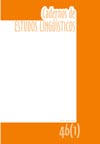Resumen
This paper discusses the language modalities. I will first discuss spoken language – its characteristics and its uses. Next I will comment on written language and in the following section I will discuss the written language produced for synchronous communication through the internet. Besides having presented a new means of communication, the written language produced in real time has presented a new language modality that unites characteristics of both spoken and written language. I will argue that a dichotomy between the two language modalities does not justify and that the differences between spoken and written language are related to the function for which a text is produced.Citas
BIESENBACH-LUCAS S. & WEASENFORTH, D. (2001). E-Mail And Word Processing In The Esl Classroom: How The Medium Affects The Message. Language Learning & Technology, vol. 5 nº 1 (p. 135-165).
BYGATE, M. (1998). Theoretical Perspectives on Speaking. Annual Review of Applied Linguistics, n. 18, pg. 20-42.
CHAFE, W. (1984). Integration and Involvement in Speaking, Writing and Oral Literature. In: Tannen, D. (org.). Spoken and Written Language: Exploring Orality and literacy. Norwwod, New Jersey.
Chafe, W. & TANNEN, D. (1987). The Relation between Written and Spoken language. Annual Review of Anthropology, vol. 16.
CHAFE, W. (1994). Discourse, Consciousness, and Time. The flow and Displacement of Conscious Experience in Speaking and Writing. The University of Chicago Press.
CHAPELLE, C.A. (1998). Multimedia Call: Lessons to be learned from research on instructed SLA. Language Learning and Technology, vol. 2 nº1, p. 22 - 34. Online. Disponível na Internet http://llt.msu.edu/vol2num1/ article1/index.html.
CHEN, G. (1998). Intercultural Communication via E-mail Debate. The Edge: The E-Journal of Intercultural Relations, vol. 1, nº4. Disponível na Internet http://www.hart-li.com/biz/theedge.
COLLOT, M. & BELMORE, N. (1993). Eletronic Language: A new Variety of English. In: Aarts J., Haan P., Oostdijk (org.), English Language Corpora: Design and Exploitation.
GAINS, J. (1999). - Eletronic Mail – A New Style of Communication or just a New Medium?: An Investigation into the Text Features of E-mail. English For Specific Purposes, vol. 18, n. 1, p.81-101.
GIMENEZ, J.C. (2000).Business e-mail Communication: Some Emerging Tendencies in Register. English for Specific Purposes, 19, p. 237-251.
HALLIDAY, M.A.K. (1985). Spoken and Written language – Oxford University Press.
HALLIDAY, M.A.K. & HASSAN, R. (1989). Language, context and text: aspects of language in a social semiotic perspective. Oxford University Press.
HAVELOCK, E. (1982). A Revolução da Escrita na Grécia e suas Conseqüências Culturais. Rio de Janeiro, Paz e Terra.
HAWKINS, E. (1983). Spoken and Written Language. Cambridge University Press.
KOCH, V.I. (1998). O Texto e a Construção dos Sentidos. São Paulo: Contexto.
KERN, G.R. (1995). Restructuring Classroom Interaction with Networked Computers: Effects on Quantity and Characteristics of Language Production. The Modern Language Journal, 79, IV, pg. 457-476.
LAMY, M.N. & GOODFELLOW, R. (1999). Reflective Conversation in the Language Classroom. Language Learning & Technology, vol. 02, p.43-62.
MADEIRA, F. (2001). A Comunicação em Língua Estrangeira Mediada Pelo Computador: O Impacto Na Precisão. Dissertação de Mestrado apresentado ao IEL Instituto de Estudos da Linguagem, UNICAMP. Também disponível em http://www.rau-tu.unicamp.br/nourau/sbu/document/ ?code=vtls000228723.
MARCUSCHI, L.A. (1994). Contextualização e Explicitude na Relação entre Fala e Escrita. Conferência apresentada no I Encontro Nacional Sobre Língua Falada e Ensino, UFAL, Maceió, 14-18 de março.
MARCUSCHI, L.A. (1995). Oralidade e Escrita. Conferência. I Colóquio Franco-Brasileiro sobre Linguagem e Educação – UFRN, Natal, 26-28 de junho, 17p
MÜLLER-HARTMANN. (2000). The Role of Tasks in Promoting Intercultural Learning in Eletronic learning Networks. Language Learning & Technology, vol. 4, nº 2, p - 129-147.
NEGRETTI, R. (1999). Web-Based Activities and SLA: a Conversation Analysis Research Approach. Language Learning & Teaching, vol. 3, nº1, p. 75-87.
PAOLILLO, J. (1999). The Virtual Speech Community: Social Network and Language Variation on IRC. Journal of Computer-Mediated Communication, vol. 4, nº 4.
PELITTIERI, J. (2000). Negotiation in Cyberspace: The Role of Chatting in the Development of Grammatical Competence. In: Mark Warschauer and Richard Kern (org.) Network-based Language Teaching: Concepts and Practice., p. 59-86. Cambridge University Press.
PERERA, K. (1984). Children’s Writing and Reading - Analysing Classroom Language. Blackweel & Deutsch.
TANNEN, D. (1992). Talking Voices – Repetition, dialogue, and imaginary in conversational discourse. Cambridge University Press.
WARSCHAUER, M. (1997). Computer-Mediated Collaborative Learning: Teory and Practice. The Modern Language Journal, n. 81, IV, pg. 470-481.
WARSCHAUER, M. (1998). Interaction, Negotiation and Computer-Mediated Learning. In: M. Clay (Ed.), Practical applications of educational technology in language learning. Lyon, France: National Institute of Applied Sciences.
WARSCHAUER, M. (1999). Surveying the Terrain of Literacy in Eletronic Literacies: Language, culture, and power in online education. Mahwah. NJ: Lawrence Erlbaum Associates.
WARSCHAUER, M. (2000b). The Death of Cyberspace and the Rebirth of CALL. Versão editada de palestra dada em “IATEFL and ESADE Conference”, em 2 de julho de 2000, Barcelona, Espanha.
WEASENFORTH, D. & BIESENBACH-LUCAS, S. (1997). E-mail and wordprocessed texts of non-native speakers: Distinguishable text types?. Disponível em http://www.gwu.edu/~washweb/lucas.html.
WERRY, C.C. (1996). Linguistic and interactional features of Internet Relay Chat. In: S. C. Herring (org.), Computer-mediated Communication: Linguistic, Social and Cross-cultural Perspectives. Amsterdam: Benjamins, p.47-63.
Se otorgan a la Revista CADERNOS DE ESTUDOS LINGÜÍSTICOS todos los derechos de autor relativos a los trabajos publicados. No se devolverán los originales. En virtud de su aparición en esta revista de acceso abierto, los artículos son de uso gratuito, con la debida atribución, en aplicaciones educativas y no comerciales.

